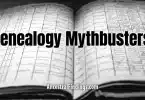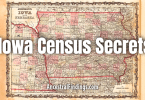If you’ve spent any time researching your family history, you’ve probably developed a familiar rhythm. You track your ancestors through the federal censuses, taken every ten years like clockwork. It’s a comforting structure: 1850, 1860, 1870… they show up like old friends, giving you names, ages, occupations, and places of birth. For many researchers, these are the backbone of American genealogy.
But then something strange happens.
You reach a point where a name disappears for a decade. Or a child is suddenly missing from the next record. A spouse appears with no record of marriage. A parent’s birthplace seems to change. And, of course, there’s the legendary hole left by the near-total destruction of the 1890 census. Entire family lines seem to evaporate for a generation.
That’s where this series begins.
Because the truth is, there’s more to the census than just those decennial snapshots. Between and around those federal enumerations are dozens of lesser-known records—some created by states, others by special federal initiatives. They didn’t always make headlines, and they weren’t always intended for genealogists. But now, they’re here, waiting to be explored. And many of them are far more detailed than you’d expect.
This series, Lost in Between, is your guide to those often-overlooked records. It’s about bridging the gaps, peeking behind the curtain, and seeing your ancestors not just as names frozen in time but as people who lived full lives between the years the federal government bothered to count them.
Why These “In-Between” Records Matter
Think of the census like a family photo album where someone only remembered to take a picture every ten years. Sure, you’ll get a sense of the story—but you’ll miss the graduations, the jobs that came and went, the moves across state lines, the illnesses, the remarriages. All the human moments that make up a life are hiding in the in-between.
State censuses, for example, were often conducted at the five-year mark between federal counts—usually to support voting districts, taxation, or school apportionment. But while their purpose may have been bureaucratic, the information they captured is anything but dull. Some states recorded birthplace, occupation, length of residency, military service, and even the names of a person’s parents—details that can be impossible to find elsewhere.
And then there are the special schedules—mortality, agriculture, veterans. These weren’t designed to be center stage, but they offer a surprising amount of texture. Want to know what your ancestor was farming? The 1850 agricultural schedule will tell you. Curious why a child vanished between 1860 and 1870? The mortality schedule might show the cause of death. Trying to track a Union veteran in 1890? The veterans’ schedule may be your only option.
The Gap That Haunts Us All: 1890
Let’s talk about it plainly—the 1890 census is gone, and it’s been breaking genealogists’ hearts for over a century. A fire at the Commerce Department building in 1921 destroyed most of the schedules, and the rest were later discarded. What we lost was more than names and numbers—it was a whole chapter of American life.
But all is not lost.
Thanks to state censuses and a few surviving federal schedules, there are ways to reconstruct what happened during that decade. You may never get the whole picture, but you can still sketch in the missing lines. That’s why this series leans hard into these alternate records. They are the next best thing—and in some cases, better than what we would have had.
Who This Series Is For
If you’re starting out, you’ll learn about new resources that aren’t in every beginner’s guide. And if you’ve been at it for years, there’s a good chance you’ve heard of these records but never looked at them closely. Maybe you didn’t know where to find them. Maybe you weren’t sure they’d be worth the time.
My hope is that this series will show you they are worth the time—and that they’re not as hard to access as you might think. Many are digitized and searchable on places like FamilySearch or Ancestry. Some are buried in state archives or special collections. I’ll show you where to look and what to expect.
And because I’ve always believed in storytelling alongside research, I’ll include real examples—short case studies showing how these records helped crack tough research questions or added rich detail to someone’s tree.
What to Expect in the Series
Here’s a sneak peek at what’s coming:
- The surprising richness of the New York state censuses (taken every ten years from 1825 to 1925)
- Why the Iowa 1925 census might be the best genealogical record you’ve never used
- How Florida’s 1945 census captured wartime families in a unique way
- Mid-decade schedules from Minnesota and Kansas
- The 1890 Veterans and Widows Schedule—a rare survivor from a vanished census year
- Mortality Schedules from 1850 to 1880—your best chance to document a death before official certificates
- And later on, we may touch on agricultural and manufacturing records, too
Each post will focus on one of these records—what it includes, how it was used, how you can access it, and how to read between the lines to pull out as much information as possible.
Ready to Fill in the Blanks?
This isn’t a crash course—it’s more of a treasure hunt. We’re not diving headfirst into every state’s census history or listing off dry data sets. We’re looking for the ones that consistently matter—the ones that have actually helped researchers find lost people, prove family connections, or understand an ancestor’s life in a whole new way.
If you’ve ever stared at a census record and wished it could tell you more, this series is for you. If you’ve ever had a ten-year gap and no idea how to close it, stick around. These next posts just might give you the tools to open that door.
So sharpen your pencils, bookmark your favorite archives, and come along as we explore the censuses that were almost forgotten. There’s more to the story than you thought—if you know where to look.






